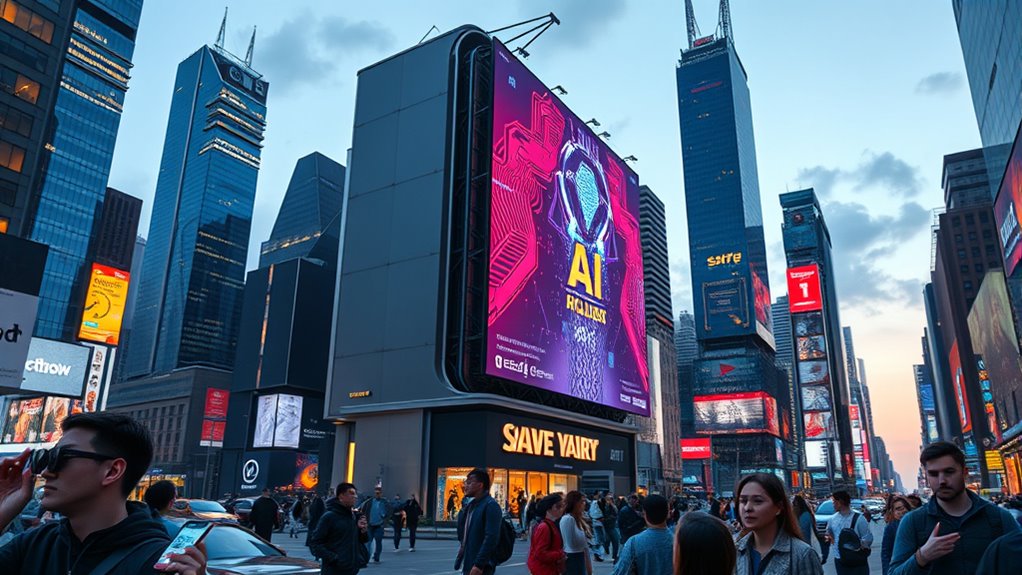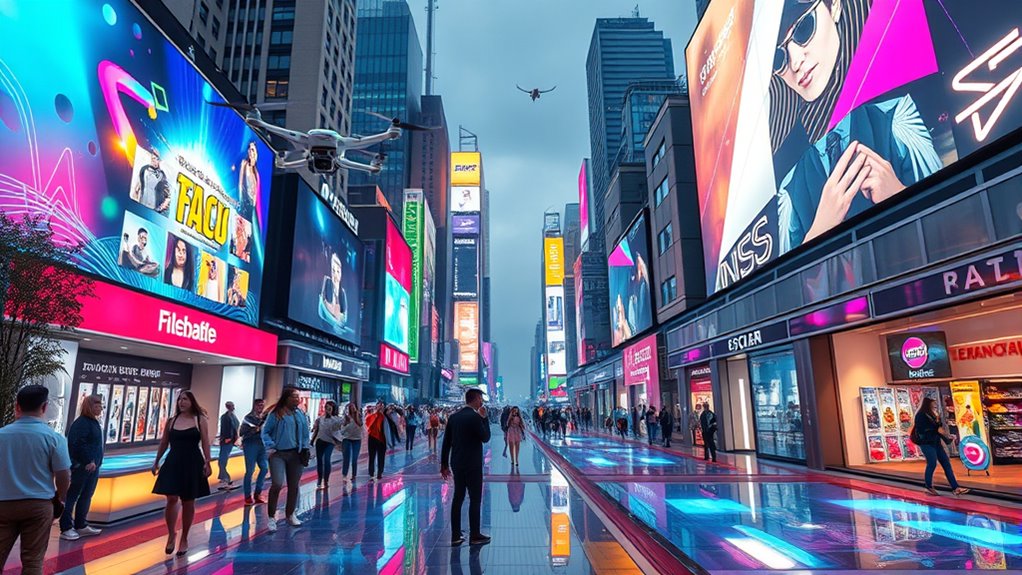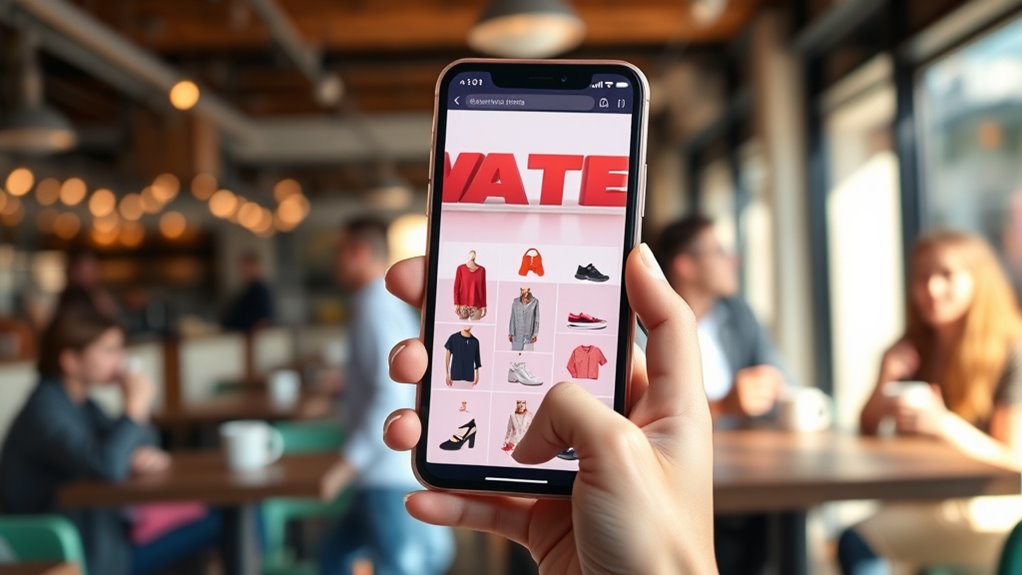In 2025, you’ll see advertising shift beyond Google and Facebook toward programmatic AI platforms that target audiences precisely and optimize campaigns automatically. Social commerce and influencer content make shopping more seamless within social apps, while voice and audio ads provide personalized, hands-free experiences. Immersive AR and VR create interactive brand environments, and niche communities allow for targeted outreach. Stay ahead by exploring these emerging channels, as they’ll reshape how you connect with consumers and grow your brand.
Key Takeaways
- Programmatic advertising and AI-powered platforms will enable smarter, faster, and more targeted ad campaigns.
- Social commerce, influencer content, and niche communities will drive direct shopping and brand engagement within social platforms.
- Voice and audio advertising will grow through voice search, smart speakers, and personalized audio experiences.
- Immersive AR and VR technologies will create interactive, memorable brand experiences beyond traditional media.
- New advertising arenas will prioritize data security, privacy, and adapting to evolving consumer behaviors and technological innovations.
The Rise of Programmatic Advertising and AI-Driven Platforms

Have you noticed how quickly digital advertising has evolved in recent years? Programmatic advertising now dominates the landscape, allowing you to target audiences more precisely than ever before. These AI-driven platforms automate ad buying, optimizing campaigns in real-time based on data insights. Instead of manual negotiations, you set your goals, and the technology handles the heavy lifting, ensuring your ads reach the right people at the right moment. This shift means you can scale campaigns faster, improve ROI, and adapt quickly to changing market conditions. As AI continues to advance, expect even smarter platforms that learn and refine strategies automatically. Incorporating vertical storage solutions into your advertising data management can streamline workflows and reduce clutter. Additionally, leveraging furniture and decor themes like farmhouse styles can help brands create more relatable and engaging ad visuals. Understanding the importance of contrast ratio in visual content can significantly enhance ad effectiveness, especially in highly competitive digital spaces. Embracing programmatic advertising is essential for staying competitive and maximizing your advertising impact in 2025.

Social commerce combines shopping directly within social media platforms, making it easier for you to buy without leaving your feed. Integrated shopping features streamline the purchase process, while influencer-led commerce guides your purchasing decisions. These innovations transform social media into a powerful channel for both discovery and sales. Additionally, the use of AI security technologies ensures that transactions and user data remain protected as social commerce continues to grow. For those seeking a cost-effective alternative, online resources and platforms simplify the process and reduce expenses associated with traditional shopping methods. As consumer preferences shift, the variety of flavor options and engaging marketing strategies further enhance the appeal of social commerce. Staying current with market research helps businesses adapt their social commerce strategies to meet evolving consumer demands. Furthermore, understanding security measures is crucial for maintaining consumer trust in these emerging channels.
Integrated Shopping Features
How are brands seamlessly blending shopping with social interactions? They’re creating virtual storefronts directly within social media platforms, making it easy for you to browse products without leaving the app. These integrated shopping features let you discover, select, and purchase items in a single, smooth experience. With seamless checkout options, you don’t need to navigate multiple pages or enter repetitive information—your payment details are often saved securely for quick transactions. This integration keeps you engaged, reducing friction and encouraging impulse buys. By merging shopping with social media, brands foster instant connection and convenience, turning passive scrolling into active purchasing. As these features evolve, expect even more frictionless experiences that make social commerce feel natural and immediate. Utilizing mobile responsiveness enhances the shopping experience on various devices, encouraging greater engagement and conversions. Furthermore, the adoption of integrated payment methods simplifies the checkout process, making it effortless for consumers to finalize their purchases. Additionally, understanding consumer behavior helps brands optimize these features for better user engagement and satisfaction. Moreover, implementing data-driven strategies enables brands to personalize shopping experiences and increase conversion rates. To stay ahead, brands are also leveraging real-time analytics to monitor user interactions and refine their social commerce strategies continuously.
Influencer-Led Commerce
Influencers are transforming social media into powerful shopping tools by endorsing products and sharing authentic experiences that resonate with their followers. Through brand collaborations, they seamlessly integrate products into their content, making recommendations feel genuine rather than scripted. This shift boosts content monetization, allowing influencers to earn directly from their engaged audiences. As social commerce evolves, influencers are taking on more active roles in driving sales, often linking products directly within posts or live streams. This merging of shopping and social media creates a seamless experience for consumers, reducing barriers to purchase. Additionally, incorporating authentic content such as personal stories and honest reviews enhances trust and encourages purchases. For brands, partnering with influencers means tapping into established trust and authentic voices, amplifying reach and engagement while accelerating conversions in this rapidly growing landscape. Leveraging vibrational alignment with consumer desires can further enhance the effectiveness of influencer marketing campaigns. Moreover, understanding the cultural significance behind influencer endorsements can deepen consumer connections and foster brand loyalty. To succeed, brands should also consider audience targeting strategies that align influencer demographics with their marketing goals. Developing trust-building techniques can help solidify long-term relationships between influencers and their audiences, increasing the likelihood of sustained engagement and sales.
The Growing Influence of Audio and Voice-Activated Ads

You’re noticing more voice-activated ads as voice commerce becomes mainstream, making it easier to shop hands-free. Personalized audio experiences let brands connect with you on a deeper level, but privacy and data concerns are also on the rise. As this trend grows, understanding how it impacts your choices is more important than ever. Additionally, Glycolic Acid benefits and innovations are increasingly integrated into these audio-driven marketing strategies to appeal to car enthusiasts and performance-minded consumers alike. Recognizing top ceiling fans and their features can also enhance your awareness of subtle signals and messages in your daily routines, paralleling how brands are using emerging channels to communicate more personally. Maintaining regular dental visits can serve as a reminder of the importance of routine checks, whether for health or staying alert to new advertising methods.
Rise of Voice Commerce
Have you noticed how voice-activated devices are transforming the way consumers shop? Voice search has become a game-changer, making it easier for people to find products and complete transactions hands-free. This shift is fueling the rise of voice commerce, where voice commands directly lead to purchases. As a result, brands are investing more in smart speaker advertising, aiming to reach consumers during their daily routines. With voice commerce expanding, you’ll see more businesses optimizing for voice search and creating voice-activated shopping experiences. This trend not only streamlines the buyer journey but also opens new avenues for targeted advertising through audio interfaces. Additionally, the integration of voice-enabled AI in education highlights how intelligent systems are becoming more personalized and accessible, further supporting the growth of voice-driven interactions. The increasing use of nutritional content in voice marketing strategies demonstrates how detailed information is being delivered directly to consumers, enhancing engagement. Recognizing the ongoing AI bifurcation helps marketers understand the importance of balancing human-centered creativity with AI-driven automation in voice advertising strategies. If you want to stay ahead, it’s essential to understand how voice search and smart speaker advertising are shaping the future of retail.
Personalized Audio Experiences
As audio and voice technology become more sophisticated, brands are increasingly crafting personalized audio experiences to engage consumers. Personalized audio uses data to tailor messages, making interactions more relevant and memorable. This approach enhances user engagement through targeted voice ads and custom playlists, creating a more immersive experience. Sonic branding plays a key role by embedding unique sounds or jingles that reinforce brand identity across various platforms. These sonic cues help consumers instantly recognize your brand, fostering loyalty and trust. By leveraging personalized audio, you can cut through the noise of traditional advertising, delivering messages that resonate on a deeper level. As voice-activated devices become more prevalent, these tailored experiences will become essential for building authentic connections with your audience.
Privacy and Data Concerns
While audio and voice-activated ads offer exciting opportunities for targeted marketing, they also raise significant privacy and data concerns. You need to be aware that these ads often collect sensitive information, making data privacy a top priority. Without proper safeguards, user consent might be overlooked, risking privacy violations. To address this, consider these key points:
- Ensuring transparent data collection practices that clearly inform users about how their data is used.
- Implementing strict user consent protocols before activating voice-activated ads.
- Regularly auditing data handling processes to prevent misuse or unauthorized access.
Augmented Reality (AR) and Virtual Reality (VR) as Advertising Arenas

Could augmented reality (AR) and virtual reality (VR) revolutionize how brands engage with consumers? Absolutely. These technologies create new advertising arenas, like virtual storefronts, where customers can browse products in a simulated environment from anywhere. With immersive branding, you can craft experiences that deeply connect your audience to your brand’s story. AR and VR enable interactive ads that go beyond static images, offering personalized and engaging encounters. You might showcase a product in a virtual home or let users try on clothes digitally. These immersive experiences boost engagement, build loyalty, and provide unique opportunities for targeting. As AR and VR become more accessible, they’ll open innovative pathways to captivate consumers and redefine brand-consumer interactions.
Niche and Community-Based Platforms for Targeted Outreach

Have you noticed how niche and community-based platforms are transforming targeted outreach? These niche platforms enable you to connect deeply with specific audiences, making your community outreach more effective. They foster authentic engagement by focusing on shared interests, values, or identities. To leverage these platforms effectively, consider:
- Identifying niche communities aligned with your brand’s mission
- Customizing messaging to resonate with community-specific language and concerns
- Building relationships over time through genuine participation rather than overt advertising
This approach helps you cut through the noise of broad channels, ensuring your message reaches the right people. Niche and community-based platforms offer precise outreach opportunities that traditional channels often overlook, making your campaigns more impactful and meaningful.
The Expansion of Shoppable Content on Visual-Centric Networks

As brands harness niche and community-based platforms for targeted outreach, they’re also exploring how visual-centric networks can amplify their message through shoppable content. These platforms enable you to leverage visual storytelling, making products more engaging and easier to purchase directly within the content. Influencer collaborations play a pivotal role, as influencers showcase products in authentic, relatable ways that resonate with their audiences. Shoppable posts on networks like Instagram and TikTok streamline the customer journey, reducing friction between discovery and purchase. This expansion allows you to turn passive viewers into active buyers seamlessly, increasing conversion rates. By integrating compelling visuals with direct shopping options, you create immersive experiences that boost brand visibility and drive sales in a way traditional ads can’t match.
Frequently Asked Questions
How Will Privacy Regulations Impact Emerging Advertising Channels by 2025?
You’ll need to prioritize privacy compliance and data protection as privacy regulations tighten by 2025. Emerging advertising channels will face stricter rules, requiring you to adapt your strategies to respect user privacy while still reaching audiences effectively. By implementing transparent data practices and leveraging privacy-first tools, you can navigate these changes successfully, maintaining trust and compliance without sacrificing your campaign performance in this evolving landscape.
What Are the Ethical Considerations for Ai-Driven Personalized Advertising?
When you consider AI-driven personalized advertising, you must prioritize ethical issues like consumer consent and algorithmic bias. You should guarantee consumers willingly agree to data collection and personalization processes. Additionally, you need to be aware of biases in algorithms that could unfairly target or exclude certain groups. By addressing these concerns, you can build trust and create responsible advertising campaigns that respect consumer rights and promote fairness.
How Can Small Businesses Effectively Leverage Niche Platforms for Advertising?
You can effectively leverage niche platforms by building local partnerships with community groups and other small businesses. Focus on content collaborations that resonate with your target audience, creating authentic and engaging material. Use these partnerships to expand your reach, foster trust, and boost your brand’s visibility. By actively engaging with niche communities and sharing valuable content, you’ll position your business for growth and stronger customer loyalty.
What Metrics Will Define Success in AR and VR Advertising Campaigns?
Your success in AR and VR advertising hinges on surpassing mere impressions—it’s about immersive engagement. Measurement benchmarks like time spent in experiences, interaction depth, and conversion rates will define your campaign’s impact. Engagement metrics such as gesture interactions, shared content, and repeat visits are essential. If you track these closely, you’ll see how effectively your virtual campaigns captivate audiences and generate meaningful results beyond traditional metrics.
How Will Evolving Consumer Behaviors Influence Future Ad Channel Effectiveness?
You’ll find that evolving consumer behaviors greatly impact ad channel effectiveness. As consumers seek more personalized experiences, your focus on consumer engagement and ad personalization becomes vital. You’ll need to adapt quickly, leveraging data-driven insights to craft targeted, relevant messages. This shift means channels that foster interaction and tailored content will outperform traditional ones, making your campaigns more impactful by aligning with how consumers prefer to engage and receive personalized advertising.
Conclusion
As you step into 2025, imagine your advertising landscape transforming like a vibrant mosaic, each piece representing new channels beyond Google and Facebook. Embrace programmatic AI, social commerce, AR, and niche platforms, where your message can seamlessly blend into users’ daily lives. These emerging channels paint a vivid picture of opportunity—don’t just watch from the sidelines—dive in and shape the future of digital advertising, turning your brand into a living, breathing part of your audience’s world.










